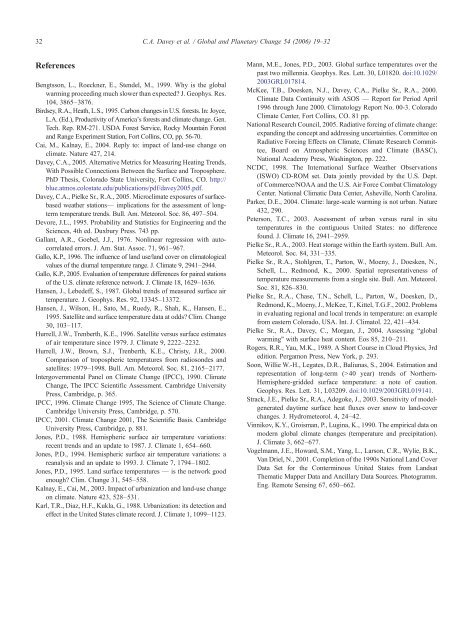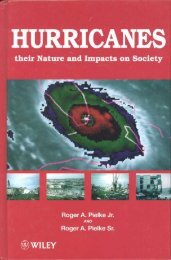Equivalent temperature - Climate Science: Roger Pielke Sr.
Equivalent temperature - Climate Science: Roger Pielke Sr.
Equivalent temperature - Climate Science: Roger Pielke Sr.
Create successful ePaper yourself
Turn your PDF publications into a flip-book with our unique Google optimized e-Paper software.
32 C.A. Davey et al. / Global and Planetary Change 54 (2006) 19–32<br />
References<br />
Bengtsson, L., Roeckner, E., Stendel, M., 1999. Why is the global<br />
warming proceeding much slower than expected? J. Geophys. Res.<br />
104, 3865–3876.<br />
Birdsey, R.A., Heath, L.S., 1995. Carbon changes in U.S. forests. In: Joyce,<br />
L.A. (Ed.), Productivity of America's forests and climate change. Gen.<br />
Tech. Rep. RM-271. USDA Forest Service, Rocky Mountain Forest<br />
and Range Experiment Station, Fort Collins, CO, pp. 56-70.<br />
Cai, M., Kalnay, E., 2004. Reply to: impact of land-use change on<br />
climate. Nature 427, 214.<br />
Davey, C.A., 2005. Alternative Metrics for Measuring Heating Trends,<br />
With Possible Connections Between the Surface and Troposphere.<br />
PhD Thesis, Colorado State University, Fort Collins, CO. http://<br />
blue.atmos.colostate.edu/publications/pdf/davey2005.pdf.<br />
Davey, C.A., <strong>Pielke</strong> <strong>Sr</strong>., R.A., 2005. Microclimate exposures of surfacebased<br />
weather stations— implications for the assessment of longterm<br />
<strong>temperature</strong> trends. Bull. Am. Meteorol. Soc. 86, 497–504.<br />
Devore, J.L., 1995. Probability and Statistics for Engineering and the<br />
<strong>Science</strong>s, 4th ed. Duxbury Press. 743 pp.<br />
Gallant, A.R., Goebel, J.J., 1976. Nonlinear regression with autocorrelated<br />
errors. J. Am. Stat. Assoc. 71, 961–967.<br />
Gallo, K.P., 1996. The influence of land use/land cover on climatological<br />
values of the diurnal <strong>temperature</strong> range. J. <strong>Climate</strong> 9, 2941–2944.<br />
Gallo, K.P., 2005. Evaluation of <strong>temperature</strong> differences for paired stations<br />
of the U.S. climate reference network.J.<strong>Climate</strong>18,1629–1636.<br />
Hansen, J., Lebedeff, S., 1987. Global trends of measured surface air<br />
<strong>temperature</strong>. J. Geophys. Res. 92, 13345–13372.<br />
Hansen, J., Wilson, H., Sato, M., Ruedy, R., Shah, K., Hansen, E.,<br />
1995. Satellite and surface <strong>temperature</strong> data at odds? Clim. Change<br />
30, 103–117.<br />
Hurrell, J.W., Trenberth, K.E., 1996. Satellite versus surface estimates<br />
of air <strong>temperature</strong> since 1979. J. <strong>Climate</strong> 9, 2222–2232.<br />
Hurrell, J.W., Brown, S.J., Trenberth, K.E., Christy, J.R., 2000.<br />
Comparison of tropospheric <strong>temperature</strong>s from radiosondes and<br />
satellites: 1979–1998. Bull. Am. Meteorol. Soc. 81, 2165–2177.<br />
Intergovernmental Panel on <strong>Climate</strong> Change (IPCC), 1990. <strong>Climate</strong><br />
Change, The IPCC Scientific Assessment. Cambridge University<br />
Press, Cambridge, p. 365.<br />
IPCC, 1996. <strong>Climate</strong> Change 1995, The <strong>Science</strong> of <strong>Climate</strong> Change.<br />
Cambridge University Press, Cambridge, p. 570.<br />
IPCC, 2001. <strong>Climate</strong> Change 2001, The Scientific Basis. Cambridge<br />
University Press, Cambridge, p. 881.<br />
Jones, P.D., 1988. Hemispheric surface air <strong>temperature</strong> variations:<br />
recent trends and an update to 1987. J. <strong>Climate</strong> 1, 654–660.<br />
Jones, P.D., 1994. Hemispheric surface air <strong>temperature</strong> variations: a<br />
reanalysis and an update to 1993. J. <strong>Climate</strong> 7, 1794–1802.<br />
Jones, P.D., 1995. Land surface <strong>temperature</strong>s — is the network good<br />
enough? Clim. Change 31, 545–558.<br />
Kalnay, E., Cai, M., 2003. Impact of urbanization and land-use change<br />
on climate. Nature 423, 528–531.<br />
Karl, T.R., Diaz, H.F., Kukla, G., 1988. Urbanization: its detection and<br />
effect in the United States climate record. J. <strong>Climate</strong> 1, 1099–1123.<br />
Mann, M.E., Jones, P.D., 2003. Global surface <strong>temperature</strong>s over the<br />
past two millennia. Geophys. Res. Lett. 30, L01820. doi:10.1029/<br />
2003GRL017814.<br />
McKee, T.B., Doesken, N.J., Davey, C.A., <strong>Pielke</strong> <strong>Sr</strong>., R.A., 2000.<br />
<strong>Climate</strong> Data Continuity with ASOS — Report for Period April<br />
1996 through June 2000. Climatology Report No. 00-3. Colorado<br />
<strong>Climate</strong> Center, Fort Collins, CO. 81 pp.<br />
National Research Council, 2005. Radiative forcing of climate change:<br />
expanding the concept and addressing uncertainties. Committee on<br />
Radiative Forcing Effects on <strong>Climate</strong>, <strong>Climate</strong> Research Committee,<br />
Board on Atmospheric <strong>Science</strong>s and <strong>Climate</strong> (BASC),<br />
National Academy Press, Washington, pp. 222.<br />
NCDC, 1998. The International Surface Weather Observations<br />
(ISWO) CD-ROM set. Data jointly provided by the U.S. Dept.<br />
of Commerce/NOAA and the U.S. Air Force Combat Climatology<br />
Center. National Climatic Data Center, Asheville, North Carolina.<br />
Parker, D.E., 2004. <strong>Climate</strong>: large-scale warming is not urban. Nature<br />
432, 290.<br />
Peterson, T.C., 2003. Assessment of urban versus rural in situ<br />
<strong>temperature</strong>s in the contiguous United States: no difference<br />
found. J. <strong>Climate</strong> 16, 2941–2959.<br />
<strong>Pielke</strong> <strong>Sr</strong>., R.A., 2003. Heat storage within the Earth system. Bull. Am.<br />
Meteorol. Soc. 84, 331–335.<br />
<strong>Pielke</strong> <strong>Sr</strong>., R.A., Stohlgren, T., Parton, W., Moeny, J., Doesken, N.,<br />
Schell, L., Redmond, K., 2000. Spatial representativeness of<br />
<strong>temperature</strong> measurements from a single site. Bull. Am. Meteorol.<br />
Soc. 81, 826–830.<br />
<strong>Pielke</strong> <strong>Sr</strong>., R.A., Chase, T.N., Schell, L., Parton, W., Doesken, D.,<br />
Redmond, K., Moeny, J., McKee, T., Kittel, T.G.F., 2002. Problems<br />
in evaluating regional and local trends in <strong>temperature</strong>: an example<br />
from eastern Colorado, USA. Int. J. Climatol. 22, 421–434.<br />
<strong>Pielke</strong> <strong>Sr</strong>., R.A., Davey, C., Morgan, J., 2004. Assessing “global<br />
warming” with surface heat content. Eos 85, 210–211.<br />
<strong>Roger</strong>s, R.R., Yau, M.K., 1989. A Short Course in Cloud Physics, 3rd<br />
edition. Pergamon Press, New York, p. 293.<br />
Soon, Willie W.-H., Legates, D.R., Baliunas, S., 2004. Estimation and<br />
representation of long-term (N40 year) trends of Northern-<br />
Hemisphere-gridded surface <strong>temperature</strong>: a note of caution.<br />
Geophys. Res. Lett. 31, L03209. doi:10.1029/2003GRL019141.<br />
Strack, J.E., <strong>Pielke</strong> <strong>Sr</strong>., R.A., Adegoke, J., 2003. Sensitivity of modelgenerated<br />
daytime surface heat fluxes over snow to land-cover<br />
changes. J. Hydrometeorol. 4, 24–42.<br />
Vinnikov, K.Y., Groisman, P., Lugina, K., 1990. The empirical data on<br />
modern global climate changes (<strong>temperature</strong> and precipitation).<br />
J. <strong>Climate</strong> 3, 662–677.<br />
Vogelmann, J.E., Howard, S.M., Yang, L., Larson, C.R., Wylie, B.K.,<br />
Van Driel, N., 2001. Completion of the 1990s National Land Cover<br />
Data Set for the Conterminous United States from Landsat<br />
Thematic Mapper Data and Ancillary Data Sources. Photogramm.<br />
Eng. Remote Sensing 67, 650–662.














